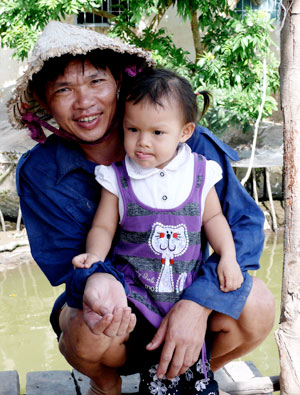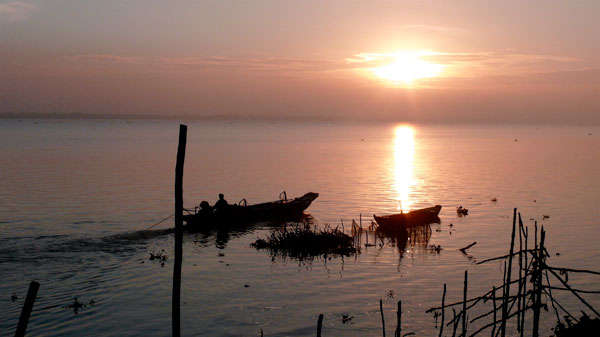CAI BE, VIETNAM – The crew of the Cai Be Princess welcomed us aboard their long flat boat with a warning: “mind your head.”
The sleek craft that ferries pilgrim travellers up and down the colourful Mekong River has a low-hanging canopy shell to protect passengers from the searing sun and heat that hangs over this important agricultural region most of the year.
Despite the warning, though, large-sized westerners regularly smack their heads against the canopy when racing to the front of the boat to capture the photographic splendours this area, known as the Mekong Delta, has to offer. There’s much to photograph here – so lots of sore heads by the end of the journey.
The Princess is just one of many handmade teakwood long boats patrolling the Mekong between the floating market town of Cai Be and the upper part of the river known locally as the Tien. The larger long boats can accommodate as many as 20 passengers but the Princess is a more intimate craft, built for two.
The larger vessels stay pretty close to the floating market at Cai Be but the Princess makes longer excursions and is preferred by tourists who combine a Mekong cruise with a Vietnamese home stay. Our overnight voyage up river would include a home stay with a Vietnamese family on one of Cai Ba’s outer islands, Vinh Long.
Home stays are becoming more and more popular with tourists to Vietnam. In fact, the country’s tourism office says home stays are now the second most sought-after activity by tourists after visits to the Cu Chi tunnels, those underground hideouts located outside Saigon that were used so effectively by Viet Cong fighters in their wars against France and the United States.
The main channel at Cai Be was filled with dozens of large junks, all overloaded with every kind of fruit and vegetable imaginable, when we entered it. The junks gather in the middle of the channel and smaller boats sail out to meet them and buy their produce.
The Mekong Delta is the bread basket of Vietnam, supplying this mostly uninhabitable country with much of its fruits and vegetables. The bulk of the 40 million tonnes of rice produced annually in Vietnam for export and its 83 million citizens comes from the Mekong Delta.


Left: A proud papa and his daughter. Right: Fishermen are up at dawn hoping to have a good day.
As we sailed past the floating market Cai Be’s handsome cathedral, built by the French in 1927, came into view. While most Vietnamese are members of the Buddhist faith, there remains a strong Catholic presence in this communist country. In fact, a large portion of Cai Be’s 40,000 population still call themselves Catholics.
Cuong (pronounced Kong “like King Kong or Viet Cong,” he told us) was our guide for this Mekong River adventure and as we moved out of the main channel he asked if we’d like to stop the at a local candy factory.
The family-run factory produces caramel treats made of coconut milk and peanuts and expertly creates a puffed rice candy by hand using ancient woks that have been used by family members for centuries.
The wonderful part of a Mekong Delta cruise is that you can stop at villages along the way and meet the gentle, hard working people of this region, who always have a smile or a wave for strangers floating past on a slow-moving boat.
Returning to the boat, the only female crew, a slight young woman named Yum, offered us her hand as we climbed aboard and always cautioned: “Watch your head” with a sly smile. It became a standing joke with us and soon she was no longer Yum, but rather “Watchyourhead”.
“I have a surprise for you,” said Cuong as we slowly chugged along. “We will visit a special place for lunch - a replica of a French colonial villa that is the best restaurant in the Delta.”
Le Longanier Restaurant, named after a lychee-type fruit grown in the region, is a stately open-air home that was built five years ago in the style preferred by French aristocrats – the land owners and occupiers of the day - 100 years ago. The lovely gardens that surround the small but palatial home are a delight to wander and the food, served on a second floor balcony overlooking the floral splendour, is Michelin star quality. A local delicacy, a meaty elephant ear fish caught just hours earlier in the Mekong River, was expertly filleted by one of the charming all-female staff whose traditional dress just added to the delightful dining experience. Between 50 and 150 tourists (depending on the season) stop at Le Longanier daily and soon the owners say they will be offering a home-stay element of their own.
The restaurant owners also owned our boat, the Cai Ba Princess, and offer larger craft preferred by honeymooners and small families. The larger long boats allow for overnight sleeps while anchored in the Mekong. Those larger boats also offer bedrooms and bathrooms and meals are served right on board.
By the time we got back to the Princess, “Watchyourhead” was waiting with cold towels and her usual warning and Cuong informed us our next stop would be at a home stay property – not the one we would eventually spend the night at, however.
The captain and his hardworking crew pulled the Princess as close to the muddy shore as they could and we took a short walk down a narrow country path before coming upon a wrought iron gate protecting a lovely garden behind.
Ba Duc is a traditional home built over 100 years ago by the local Mandarin. A group of French tourists were busy packing their bags after what they described as a “bonne nuit” at the old house run by the third son of the late Mandarin.
“The word ‘ba’ refers to the third son,” Cuong told us as an old man – ba – approached. After the communists unified the country, they seized all the land and many of the Mandarin’s exploited workers took their revenge out on the land owners.
“Most of the Mandarin’s were taken to their rice field and shot and left to rot in the sun,” said Cuong about one of Vietnam’s darkest periods. “Ba’s father was revered by his workers so they allowed him to live.”
An alter in the entrance of Ba Duc honours Ba’s father and other late relatives, whose ancestral home is one of the most attractive in the area. It comes complete with splendid gardens and six guest rooms that are rented out for about $30 a night – meals included – to passing tourists. The rooms are extremely clean, air conditioned, come with a TV and two beds and even offer private bathroom facilities. Ba Duc whetted our appetites for what we would be staying in later that night.
It’s hard not to think of the movie Apocalypse Now as you drift slowly on the Mekong. The haunting scenes from that iconic Vietnam War film of American forces being ambushed by the Viet Cong from the thick vegetation that lines both sides of the narrow river comes rushing back as we proceed.
Beautiful water hyacinths, which provided the Vietnamese fighters with perfect cover, can be found in abundance here. Local women now cut the purple plant’s hardy stem, let it dry and then use it to weave baskets. The large leaves are discarded into the river where they sometimes become entangled in propellers.
We soon found ourselves in the upper river, or the Tien. That’s where the Mekong widens and branches off in different directions – to Thailand and Cambodia. It’s also where our home stay accommodation was located – hidden in the thick Vietnamese jungle.
One look at Mai Quoc Nam 2, the name of the home-stay property, and we realized this was more camp than home.
The Diem family lived in one wing of the stilted “home” which offered shared sleeping quarters, shared washroom and shared dining – even the family’s pet snakes had to share their glass cage. Army cots, not beds, was where we would sleep, wrapped in mosquito netting and a single fan to keep us cool during the hot, humid night.
Boot camp for travellers, is what the Danish couple bunked next to us – rooms are separated only by curtains – called the “home."
However, the meals served by Mrs. Diem and her sister were hearty and tasty and their enthusiasm and interest for whence we came was truly heartening. And, we discovered, the cots were actually comfortable and the netting and fan kept the jumbo-sized insects off us.
As the sun dipped slowly into the Mekong that evening, we watched as Mr. Diem waded neck deep into the shallow water just offshore to retrieve fish and shrimps from the primitive bamboo netting he uses. The catch of the day would be served to us later that evening in some spicy local dishes.
A walk around the small jungle village introduced us to rural life in the Delta – kids cooled off in the murky Mekong water; men cut large timber on an old saw into the shape of wooden beams to be used in homes; mothers swept doorsteps; old men flashed toothless smiles. All in all, a wonderful experience was had by all and worth every cent of the $35 the family charges for this soft adventure experience.
Next morning, after a good night’s sleep, Mrs. Diem packed some homemade sweet cakes into a bag and sent us on our way back down the Mekong towards Cai Ba. However, Cuong had another “surprise” in store – a stop at a flower town known as Sa Dec, which is also the brick-making capital of Viet Nam.
“French tourists love stopping in Sa Dec because that is where a very famous home is located,” said Cuong – “the former home of a very rich Mandarin family whose son fell in love with a beautiful French woman who later wrote a book about their love affair.”
The book (L’Amant or the The Lover, written by French novelist Marguerite Duras) was later turned into a classic film. Duras’ Chinese lover, Huynh Thuy Le, eventually married another woman chosen by his family but continued his torrid love affair with Duras. The house his family lived in and Duras’ nearby family home are both museums today.
As fascinating as the houses were, the town’s brick yards were the highlights of our short stay in Sa Dec. Strong-backed women do most of the work at the over 200 brick works that line the Mekong shoreline. They carry the clay to the press and then stack the formed bricks afterwards. The men stoke the fires, fuelled by rice husks, and the clay bricks bake at temperatures of 1,000 degrees Fahrenheit for a week. The bricks then take a month to cool.
It was at Sa Dec that our driver was waiting to take us back to Ho Chi Minh City (Saigon), a three hour drive away.
As we left the Cai Be Princess for the final time, “Watchyourhead” had one final warning for me – “watch your step,” she said with a sly smile and a wink.
It’s hard not to love the people of the Mekong Delta.